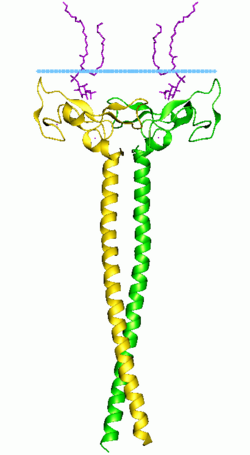
In cell biology, a phagosome is a vesicle formed around a particle engulfed by a phagocyte via phagocytosis. Professional phagocytes include macrophages, neutrophils, and dendritic cells (DCs).

Phosphatidylinositol 3-phosphate (PtdIns3P) is a phospholipid found in cell membranes that helps to recruit a range of proteins, many of which are involved in protein trafficking, to the membranes. It is the product of both the class II and III phosphoinositide 3-kinases activity on phosphatidylinositol.

Phosphatidylinositol 3,5-bisphosphate is one of the seven phosphoinositides found in eukaryotic cell membranes. In quiescent cells, the PtdIns(3,5)P2 levels, typically quantified by HPLC, are the lowest amongst the constitutively present phosphoinositides. They are approximately 3 to 5-fold lower as compared to PtdIns3P and PtdIns5P levels, and more than 100-fold lower than the abundant PtdIns4P and PtdIns(4,5)P2. PtdIns(3,5)P2 was first reported to occur in mouse fibroblasts and budding yeast S. cerevisiae in 1997. In S. cerevisiae PtdIns(3,5)P2 levels increase dramatically during hyperosmotic shock. The response to hyperosmotic challenge is not conserved in most tested mammalian cells except for differentiated 3T3L1 adipocytes.
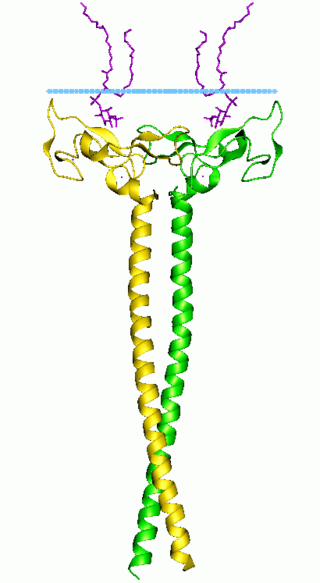
In molecular biology the FYVE zinc finger domain is named after the four cysteine-rich proteins: Fab 1, YOTB, Vac 1, and EEA1, in which it has been found. FYVE domains bind phosphatidylinositol 3-phosphate, in a way dependent on its metal ion coordination and basic amino acids. The FYVE domain inserts into cell membranes in a pH-dependent manner. The FYVE domain has been connected to vacuolar protein sorting and endosome function.

FYVE, RhoGEF and PH domain-containing protein 1 (FGD1) also known as faciogenital dysplasia 1 protein (FGDY), zinc finger FYVE domain-containing protein 3 (ZFYVE3), or Rho/Rac guanine nucleotide exchange factor FGD1 is a protein that in humans is encoded by the FGD1 gene that lies on the X chromosome. Orthologs of the FGD1 gene are found in dog, cow, mouse, rat, and zebrafish, and also budding yeast and C. elegans. It is a member of the FYVE, RhoGEF and PH domain containing family.
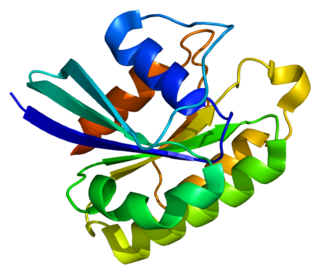
Ras-related protein Rab-5A is a protein that in humans is encoded by the RAB5A gene.
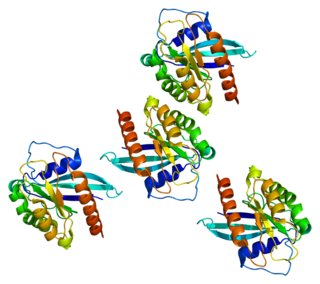
Ras-related protein Rab-7a is a protein that in humans is encoded by the RAB7A gene.

Hepatocyte growth factor-regulated tyrosine kinase substrate is an enzyme that in humans is encoded by the HGS gene.

Syntaxin-6 is a protein that in humans is encoded by the STX6 gene.

PIKfyve, a FYVE finger-containing phosphoinositide kinase, is an enzyme that in humans is encoded by the PIKFYVE gene.

Rab11 family-interacting protein 5 is a protein that in humans is encoded by the RAB11FIP5 gene.

Ras-related protein Rab-22A is a protein that in humans is encoded by the RAB22A gene.

Phosphatidylinositol 4-kinase 2-alpha is an enzyme that in humans is encoded by the PI4K2A gene.
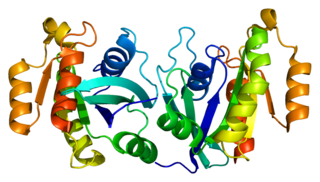
Ras-related protein Rab-11B is a protein that in humans is encoded by the RAB11B gene. Rab11b is reported as most abundantly expressed in brain, heart and testes.

Zinc finger FYVE domain-containing protein 16 is a protein that in humans is encoded by the ZFYVE16 gene.

Zinc finger FYVE domain-containing protein 1 is a protein that in humans is encoded by the ZFYVE1 gene.

GTPase activating protein and VPS9 domains 1, also known as GAPVD1, Gapex-5 and RME-6 is a protein which in humans is encoded by the GAPVD1 gene.

FYVE, RhoGEF and PH domain-containing protein 2 (FGD2), also known as zinc finger FYVE domain-containing protein 4 (ZFYVE4), is a protein that in humans is encoded by the FGD2 gene.

RUN and FYVE domain containing 2 (RUFY2) is a protein that in humans is encoded by the RUFY2 gene. The RUFY2 gene is named for two of its domains, the RUN domain and FYVE domains. RUFY2 is a member of the RUFY family of proteins that include RUFY1, RUFY2, RUFY3, and RUFY4. RUFY2 protein has a dynamic role in endosomal membrane trafficking.

The SNX8 is a sorting nexin protein involved in intracellular molecular traffic from the early endosomes to the TGN. It is suggested that it acts as an adaptor protein in events related to immune response and cholesterol regulation, for example. As a protein of the SNXs family, the SNX8 is formed of 465 aminoacids and presents a BAR-domain and a PX-domain which are very relevant in relation to its functions. Furthermore, SNX8 study is motivated by its medical significance in relation to diseases such as Alzheimer's Disease, cancer, neurodevelopmental malformations and to its role in fighting against viral infections.
